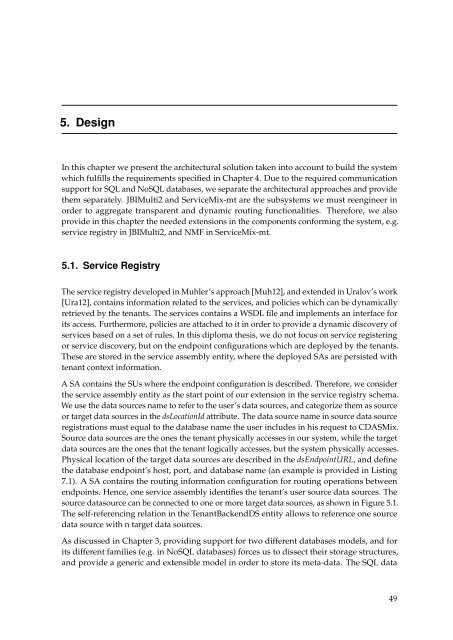Diploma Thesis Santiago Gómez Sáez - IAAS
Diploma Thesis Santiago Gómez Sáez - IAAS
Diploma Thesis Santiago Gómez Sáez - IAAS
Create successful ePaper yourself
Turn your PDF publications into a flip-book with our unique Google optimized e-Paper software.
5. Design<br />
In this chapter we present the architectural solution taken into account to build the system<br />
which fulfills the requirements specified in Chapter 4. Due to the required communication<br />
support for SQL and NoSQL databases, we separate the architectural approaches and provide<br />
them separately. JBIMulti2 and ServiceMix-mt are the subsystems we must reengineer in<br />
order to aggregate transparent and dynamic routing functionalities. Therefore, we also<br />
provide in this chapter the needed extensions in the components conforming the system, e.g.<br />
service registry in JBIMulti2, and NMF in ServiceMix-mt.<br />
5.1. Service Registry<br />
The service registry developed in Muhler’s approach [Muh12], and extended in Uralov’s work<br />
[Ura12], contains information related to the services, and policies which can be dynamically<br />
retrieved by the tenants. The services contains a WSDL file and implements an interface for<br />
its access. Furthermore, policies are attached to it in order to provide a dynamic discovery of<br />
services based on a set of rules. In this diploma thesis, we do not focus on service registering<br />
or service discovery, but on the endpoint configurations which are deployed by the tenants.<br />
These are stored in the service assembly entity, where the deployed SAs are persisted with<br />
tenant context information.<br />
A SA contains the SUs where the endpoint configuration is described. Therefore, we consider<br />
the service assembly entity as the start point of our extension in the service registry schema.<br />
We use the data sources name to refer to the user’s data sources, and categorize them as source<br />
or target data sources in the dsLocationId attribute. The data source name in source data source<br />
registrations must equal to the database name the user includes in his request to CDASMix.<br />
Source data sources are the ones the tenant physically accesses in our system, while the target<br />
data sources are the ones that the tenant logically accesses, but the system physically accesses.<br />
Physical location of the target data sources are described in the dsEndpointURL, and define<br />
the database endpoint’s host, port, and database name (an example is provided in Listing<br />
7.1). A SA contains the routing information configuration for routing operations between<br />
endpoints. Hence, one service assembly identifies the tenant’s user source data sources. The<br />
source datasource can be connected to one or more target data sources, as shown in Figure 5.1.<br />
The self-referencing relation in the TenantBackendDS entity allows to reference one source<br />
data source with n target data sources.<br />
As discussed in Chapter 3, providing support for two different databases models, and for<br />
its different families (e.g. in NoSQL databases) forces us to dissect their storage structures,<br />
and provide a generic and extensible model in order to store its meta-data. The SQL data<br />
49

















